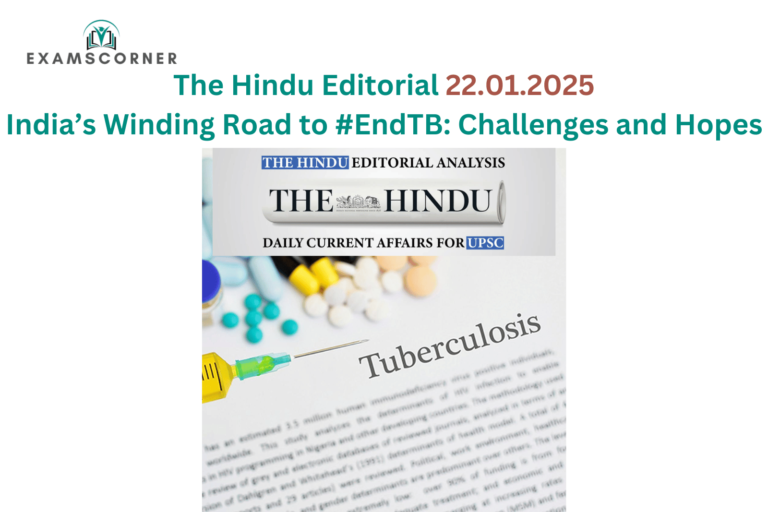Introduction
Tuberculosis (TB) continues to be a global public health crisis, claiming the top spot as the leading infectious disease killer in the world. Despite ambitious global End TB targets, including a 90% reduction in TB deaths, an 80% decrease in new cases, and zero TB-affected families facing catastrophic costs by 2030, progress remains slow.
India, which accounts for 26% of the global TB burden, set an accelerated target to end TB by 2025. However, setbacks like the COVID-19 pandemic have hampered progress. According to the World Health Organization’s Global Tuberculosis Report 2024, India also leads in drug-resistant TB (DR-TB) and TB-related deaths. While national policies show promise, their ground-level implementation needs significant improvement.
High-Risk and Vulnerable Groups: India’s TB Challenge
India’s National Tuberculosis Elimination Programme (NTEP) identifies vulnerable groups that face higher risks of contracting TB and suffering adverse outcomes. These include individuals exposed to factors like silicosis, undernutrition, overcrowding, and co-morbidities like diabetes.
Impact of Severe Lung Damage Cases
Many clinics in India report TB cases with severe lung damage, often caused by environmental factors like inhalation of fine dust from mining and stone carving activities.
Challenges of Migrant Workers
Migrant workers often lack access to healthcare and prefer returning to their native places when ill, making it difficult for the healthcare system to track their treatment. Addressing these issues requires a multisectoral approach that tackles underlying social determinants like undernutrition and poverty.
India’s Achievements in TB Treatment
Treatment Initiation Success
India has made significant strides, with over 95% of notified TB cases starting treatment. A dedicated procurement and supply chain system ensures the availability of NTEP drugs.
Challenges with Supply Chains
Despite this progress, 2023 saw persistent drug shortages, disrupting treatment across several regions. Beneficiaries and their families struggled to access essential medicines, leading to delayed treatments and higher risks of antibiotic resistance.
Extrapulmonary TB (EP-TB): A Growing Concern
Extrapulmonary TB affects various organs, including lymph nodes, kidneys, brain, spinal cord, bones, and skin. While pulmonary TB remains the primary focus of NTEP due to its transmissibility, EP-TB accounts for 24% of notified cases in India.
Diagnosis Challenges
EP-TB often presents vague symptoms that mimic other diseases, leading to delayed or missed diagnoses. The reliance on specialists for diagnosis further complicates timely treatment. Advanced diagnostic tests are costly and inaccessible to many, especially in rural areas.
Recommendations for Improvement
- Training general practitioners to identify EP-TB symptoms early.
- Sensitizing frontline workers and integrating EP-TB into existing screening algorithms.
- Expanding access to affordable diagnostic tools like CBNAAT and Truenat machines at local levels.
Key Challenges in TB Diagnosis and Treatment
Frequent Updates to Guidelines
Frequent updates to TB treatment guidelines require consistent dissemination and training, which remains a challenge due to a shortage of adequately trained human resources.
Diagnostic Infrastructure
- Molecular tests, critical for accurate TB diagnosis, are available only at district levels, causing delays.
- Testing machines like CBNAAT and Truenat are often unavailable, or staff and supplies are inadequate.
- Patients incur additional costs due to travel for testing, adding to their financial burden.
Staffing and Resource Constraints
The NTEP’s staffing levels do not meet the growing demands, leading to overburdened healthcare workers and delays in service delivery.
Success Stories: Lessons from Local Initiatives
India can draw inspiration from districts like Idukki in Kerala, where collaboration with Kudumbashree—a prominent women’s self-help network—led to significant progress in TB elimination efforts. Community participation, combined with advocacy from government leaders, helped achieve and sustain targets.
Such examples underscore the importance of ownership at all levels of administration and cross-learning from successful practices across geographies.
Recommendations to Achieve #EndTB Goals
- Address Drug Shortages: Establish robust supply chain mechanisms to ensure uninterrupted access to essential medicines.
- Expand Diagnostic Infrastructure: Improve access to molecular tests and deploy CBNAAT and Truenat machines at community levels.
- Focus on EP-TB: Train general practitioners and frontline workers to diagnose EP-TB early, reducing dependence on specialists.
- Multisectoral Approach: Address underlying risk factors like undernutrition, overcrowding, and silicosis through targeted interventions.
- Community Engagement: Foster partnerships with local organizations and self-help groups to promote awareness and encourage early diagnosis.
- Policy and Resource Alignment: Streamline updated guidelines and ensure adequate staffing to meet program demands.
Signs of Progress Amid Challenges
Despite the obstacles, there is hope. India’s TB case notification rates reached an all-time high, and TB-related deaths declined by 24% compared to 2015—far surpassing the global decline. Initiatives like active case finding in Vietnam demonstrate that targeted interventions can yield significant results, offering a model for India to emulate.
Conclusion
While the goal of ending TB by 2025 remains daunting, India’s National Tuberculosis Elimination Programme has the potential to adapt to contextual challenges and draw lessons from international best practices. Restructuring and redefining conventional frameworks, coupled with strong community engagement and multisectoral action, could help India turn the tide against TB and move closer to its ambitious goal of #EndTB.



